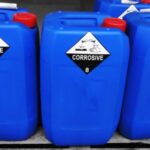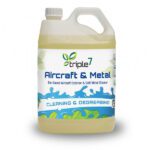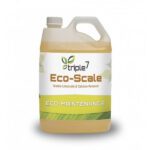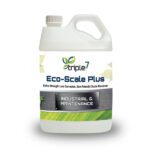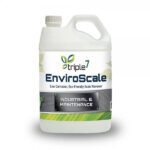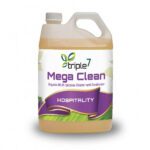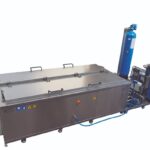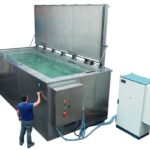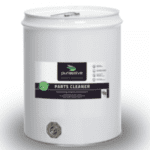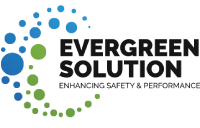Table of Contents
Industrial Cleaning: Transition from Hazardous Acids to Safer Alternatives
Introduction
Industrial cleaning has traditionally relied on acids for various applications, from rust removal and surface preparation to limescale removal and pretreatment processes. These acids, known for their quick and effective action, have long been integral to achieving desired results in industrial settings. However, the hazards associated with their use have led to increased scrutiny and widespread bans, though some still obtain them through grey markets and illegal channels. This blog explores the reasons behind these bans, the dangers of acid use, and the next-generation solutions that have emerged as safer alternatives.
Choosing the Best Limescale Preventer: Avoiding Hazards of Traditional Acids
The primary reasons for the ban on industrial acids are the severe hazards they pose, including:
Health Risks: Traditional acids can cause severe burns on the skin and damage surfaces such as steel, plastics, rubber, acrylic, wood, and glass. These injuries and damages are not only painful and costly to repair but also carry legal implications under Indian Penal Code (IPC) laws. Industrial workers are constantly at risk, with burns reported in approximately 20% of incidents in companies that use acids. This alarming statistic has driven the search for safer alternatives that can deliver the same results without the associated dangers.
Legal and Safety Concerns
The use of acids in industries leads to significant legal challenges. Companies face potential lawsuits and regulatory penalties due to the injuries and damages caused by acids. Industrial workers’ unions frequently raise concerns about the safety of their members, leading to conflicts and demands for safer working conditions. Consequently, industries are under immense pressure to find solutions that comply with safety regulations and ensure the well-being of their employees.
Next-Generation Solutions: Natural Limescale Remover for Industrial Cleaning
To address these critical issues, next-generation solutions have been developed. Two prominent alternatives are synthetic salts and oleo-based acids. These solutions offer the same efficacy as traditional acids but with significantly reduced risks.
Synthetic Salts
Synthetic salts have emerged as a viable alternative to traditional acids. These salts, which include phosphorus, nitric, sulfuric, oxalic, hydrochloric, and other mineral acids, possess all the qualities of powerful acids but with a much lower pH and reduced hazards.
Pros of Synthetic Salts vs. Acids
- Non-Flammable and Non-Hazardous: Synthetic salts do not pose the same flammability risks as traditional acids. They are non-hazardous and do not cause burn marks on the skin.
- Safe for Metals: These salts can be used on most metals without causing damage, making them versatile for various applications.
- Minimal Restrictions: Unlike traditional acids, synthetic salts do not have major restrictions for transportation, storage, usage, or disposal.
- Biodegradable: Synthetic salts are ultimately biodegradable, ensuring they do not harm the environment.
- Quick Acting: These salts act quickly, delivering efficient results.
- Compliance with Safety Norms: Synthetic salts comply with environmental, safety, and occupational monitoring agencies’ norms globally.
Cons of Synthetic Salts vs. Acids
- Higher Cost: Compared to common acids used in industries, synthetic salts are relatively expensive. This cost factor can be a deterrent for new companies.
- Skepticism and Availability: There is a degree of skepticism regarding the use of synthetic salts. Additionally, their availability in chemical shops in India is limited, which can be a barrier to widespread adoption.
- Lack of Awareness: Many industries are not aware of synthetic salts as an alternative to traditional acids, which hampers their usage.
Oleo-Based Surfactants
Oleo-based surfactants, derived from plant sources, offer an excellent alternative to mineral acids. These surfactants perform all the functions of traditional acids without the associated dangers.
Pros of Oleo-Based Surfactants vs. Mineral Acids
- Non-Burn Mark Products: Numerous tests have confirmed that oil-based products prevent burn marks, ensuring user safety.
- Safe for Fabrics: These surfactants can be used on fabrics without causing burns, tears, or disintegration, including cotton, synthetic, and mixed blends.
- Safe for Metals: Oleo-based surfactants are safe on metals, including aluminum and other soft alloys. They are also safe on rubber, plastics, glass, and acrylics.
- Biodegradable: Derived from natural resources, oleo acids are readily biodegradable, with over 75% biodegradation within 21–30 days.
- Safe Storage and Disposal: Oleo acids do not have stringent storage or disposal requirements, making them easy to handle.
- Non-Fuming: These acids do not emit toxic fumes, ensuring a safer working environment, particularly for women workers and staff.
Cons of Oleo-Based Acids vs. Mineral Acids
- Higher Cost: Oleo-based acid formulations are more expensive than mineral acids. This higher cost can limit their use to applications where the expense is justified.
- Limited Availability: Currently, oleo acids are only available in certain regions in India, such as Chennai, Delhi, Mumbai, and Jharkhand. This limited availability can be a barrier to widespread adoption.
The Future of Industrial Cleaning: Exploring Innovations in Industrial Cleaning: Effective Ways to Remove Limescale
The transition from traditional acids to safer alternatives like synthetic salts and oleo-based surfactants is a significant step forward for industrial cleaning. These next-generation solutions offer the same effectiveness as traditional acids without the associated dangers, ensuring the safety of workers and compliance with legal and environmental regulations.
Overcoming Challenges
Despite the clear benefits of synthetic salts and oleo-based surfactants, challenges to their widespread adoption remain. The higher cost of these alternatives is a significant barrier, especially for small and medium-sized enterprises. To overcome this, it is essential to increase awareness about the long-term benefits of using safer alternatives, including reduced healthcare costs for workers, lower legal risks, and a better reputation for companies prioritizing safety and environmental responsibility.
Another challenge is the lack of technical knowledge and expertise in using synthetic salts and oleo-based surfactants. Many businesses may hesitate to switch to these alternatives due to concerns about compatibility with their existing equipment or processes. To address this, providing more training programs and resources will help businesses successfully transition to safer alternatives.
Updating regulatory compliance is another obstacle to the widespread adoption of synthetic salts and oleo-based surfactants. Some industries may face strict regulations or guidelines that favor traditional chemical products over newer, safer alternatives. Regulatory bodies should consider the environmental and health benefits of these alternatives when setting standards and regulations to encourage their use.
Overall, while challenges to the widespread adoption of synthetic salts and oleo-based surfactants remain, the benefits far outweigh the obstacles. By addressing cost barriers, providing technical support, and promoting regulatory compliance, businesses can successfully transition to safer alternatives and reap the long-term benefits of improved safety and environmental responsibility.
Additionally, increasing the availability of these alternatives in more regions will be crucial. Governments and industry bodies can play a role by promoting the use of synthetic salts and oleo-based surfactants and providing incentives for companies that adopt these safer practices.
Company and government partnerships can also invest in research and development to further improve the effectiveness and accessibility of these alternatives, ultimately leading to a widespread shift away from harmful chemicals. By working together, we can create a healthier and more environmentally sustainable future for all.
Embracing Innovation
The development of synthetic salts and oleo-based surfactants is a testament to the power of innovation in addressing critical industrial challenges. As research and development continue, it is likely that even more efficient and cost-effective alternatives will emerge. Industries must remain open to embracing these innovations and investing in safer and more sustainable practices.
Conclusion
The industrial cleaning sector is transforming from hazardous traditional acids to safer and more sustainable alternatives. Synthetic salts and oleo-based surfactants represent the future of industrial cleaning, offering powerful cleaning capabilities without the associated dangers. While challenges such as higher costs and limited availability remain, the long-term benefits of these alternatives make them a worthy investment. By prioritizing safety, environmental responsibility, and innovation, industries can ensure a safer and more sustainable future for all.
Industrial cleaning is never complete without acids, but it no longer needs to rely on the dangerous acids of the past. The future is bright, with synthetic salts and oleo-based surfactants leading the way towards a safer and cleaner industrial environment.





